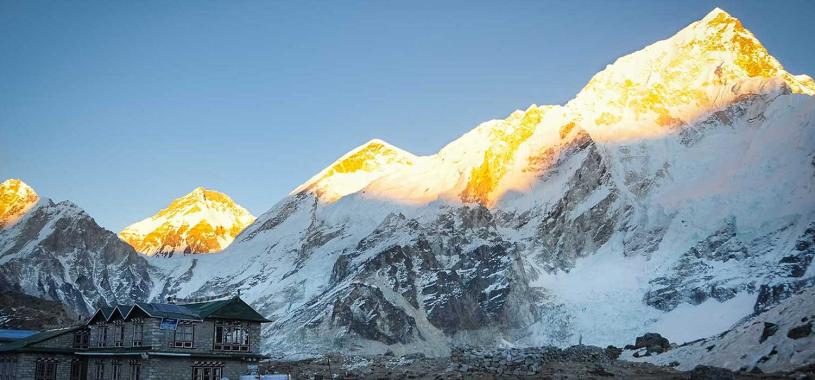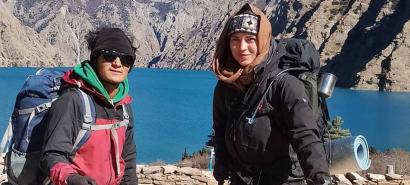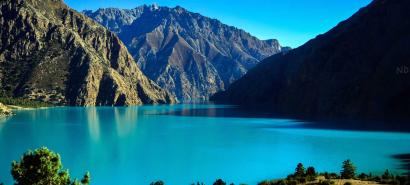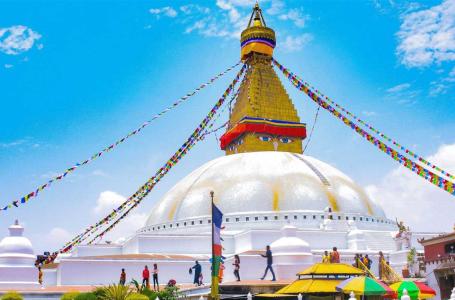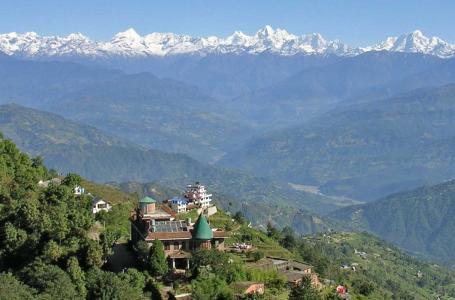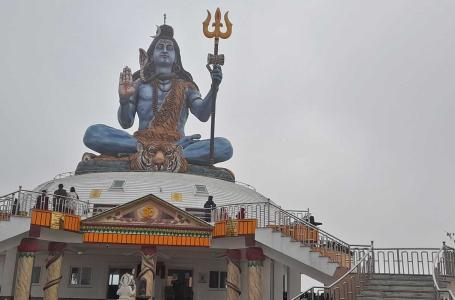- 01 Pax USD 3250 pp
- 02 to 05 Pax USD 2950 pp
- 06 to 10 Pax USD 2550 pp
- 11 to 15 Pax USD 2550 pp
Itinerary
From Kathmandu, we will catch the scenic flight to Nepalgunj that takes over just an hour to finally reach there. Nepalgunj is a hot place, where the malarial mosquitoes are ubiquitous. Most of the lodges in Nepalgunj are infamous of the bed bugs, except the few lodges. So, it is better not to expect any heavenly views from Nepalgunj. However, by the time you enter into the Dolpo region, the Himalayan vistas begin to show off.
It takes around 35 minutes to arrive at Juphal by the flight from Nepalgunj. While on the air, you could see the views of Dhaulagiri, Churen Himal, Sisne Himal, and Kanjiroba Himal following all the way up to the Juphal. It is an interesting journey. Upon arriving there, we will walk towards the Chhepka via Dunai, a beautiful apple hamlet.
As we leave Juphal, we will proceed along the gradual uphill section of the trail through the forest of shady trees and vegetations. The path goes through the maize fields to appear at Dunai, a village perched on the hillside above the Thulobheri River.
About an hour later, we will enter into the woods of Shey Phokshundo National Park at Sulighat and head on straight up to the waterfall point beyond Shyanta. There are Langurs and Himalayan monkeys paying scrutiny attention to your steps.
Finally, we will arrive at the Chhepka, a few hours later, where there are lodges- an only handful- to stay.
Today is not an easy day as there are some daunting trails that need to be crossed. This is the day when you realize that “Oh dear, I have come to the Dolpo, not the Annapurna”.
From Chhepka, we will traverse down the soul-threatening rocky ravines just to appear in a dense forest of mixed vegetation. It feels good to walk through the woods. Once you come out of the woods, we will enter into a rock-cut bluff section where the heavy torrent, gushing by the side, constantly reminds us of the dangers of falling. However, when you see the torrent through the eyes of an adrenaline junky, you will realize how amazing it is.
At places, you will see the bright yellow sign of GHT, whose meaning is quite ambiguous. Ignoring the sign, we will climb along the steep section of the trail, perhaps the steepest, to make an appearance at Rechi. It takes about 1 and a half hours, through the gorge, to arrive at Chunuwar, our next station
As we go steep from Chunuwar, we will arrive at the Polam, a nice village offering majestic views of the sheer-sided black cliffs, Baga La pass, and the Tokyu. There are caves that we will explore, beautiful juniper forest that we will pass through, magnificent waterfalls where we will come across, and the placid turquoise lakes that will keep us cool in the rest of the journey. It is indeed a surreal place to visit.
However, the frequent cliffs and rocky boulders will pressure you time and again, and at times, you may feel like quitting. But, this is what you have come for- adventure. By the time you arrive at Ringmo, you will feel each and every muscle of your leg, even the ones that you have never thought existed.
At Ringmo, we will set our camp and spend the overnight
Any free day in Dolpo is worth, especially when it comes to exploring the lakeside. Staying at Ringmo gives us a double advantage: the first thing is it aids in acclimatization and the second point is you will get the chance to witness the deepest and the second biggest lake of Nepal, Shey Phoksundo Lake.
While the path is pretty steep, it will take you to one of the most serene lakes of Nepal. This lake appears to be the oasis in the meadows. There is an ancient Tibetan monastery, by the side of the temple, which cannot be missed during the visit to Phoksundo Lake. The overall day is amazing
From Ringmo, we will follow the trail that goes by the side of the Phoksundo Khola and drops into a side canyon of silver birch, juniper, and berries. The glimmering peak of Kanjiroba Himal seems to defy us time and again, but its majestic glimpse could only be seen distinctly when we reach behind the lake shores. We will set our camp there and spend our overnight.
From Chunemba or Shey, the snowfields camp or low camp is just a few kilometers away. But the sheer-sided cliffs and ridges make the walk more challenging to pass through.
The narrow Tuk Kyaksa Khola on the way rages for short intervals where the two cliffs squeeze the path of the river. This point is where you must be very careful. A beautiful bridge and a nice valley open up after crossing a bridge, which later on takes us to a flattish area. A few distances ahead of it, there is a rocky slab where most of the trekkers have been camping prior to ascending across the Kang La pass or Nagdalo La pass.
From the Low Camp, we will wake up as soon as possible and leave our camp just after the darkness is over. We will walk past the waterfall along the rocky terrain and ascend to the Kang La pass or Nagdalo La pass. The trail zigzags for a while before ascending to the pass.
Set in between the rocky buttresses of Dolpo, Kang La pass is unexpectedly rewarding. From the deep gorges to the high brown-looking ridges, all combine in an elegant setting to form an impeccable scene. It is indeed one of the rarest seen glimpses of Nature.
However, the precarious wind will never let us enjoy the view for a long time. So, we will have to descend to Shey Gompa for the night stay. Shey Gompa is a beautiful monastery, fenced by the 8 beautiful chortens and a collection of Mani walls. The interior of this monastery is carved by the images of elephant, snow leopard, peacock, etc. Among them, the snow leopard is the commonly found animals of this region.
Beyond the monastery, there is a refuge place where we will pitch our tent for the night stay.
A rest day in Shey Gompa can be further animated with a side trip to some of the fabulous places in the isolated Kingdom of Dolpo (Dolpa). Tsakang and Drutob Senge Yeshe are two of the popular holy places that we will come across during today’s hike.
From the bridge, the trail ascends parallel to the river, on the west side of the Crystal Mountain. We will take several zigzags and ups and downs to finally make an appearance at the Tsakang Monastery.
It is a wonderful monastery with a tall and white, four-story Gompa, standing erect on its side. There is also a cave perched on top of the hill. The red cliffs, on the side, further add the charm to this monastery.
Later, we will return to Shey Gompa for the overnight stay.
From Shey Gompa, we will follow the classic routes to Seldang. There is no fixed description about the trail as it keeps on changing every now and then, except that a 900 m constant ascend to the pass is quite reminiscing.
The Sela La Pass or the Gela Pass gives us a feeling of being on top of the world. The vast rocky plains and the stony cliffs make up an interesting scenario.
We will descend along the winding trail to Namgung, which is the holy site of the Dolpo region
It is quite an easy day. But, before leaving Namgung, make sure you have explored the monastery there. It is a nice place to study Kagyu-pa sect Buddhism. The images of Guru Rinpoche, Sakyamuni Buddha, and few other legends are painted in the inside of the monastery.
From Namgung, the trail to Saldang passes down the Namga Khola (river). Only within a couple of hours of walking, we will arrive at Saldang, which is a quiet place in the valley of Nangkhong
Before leaving for Chagaon, it is better to explore the Saldang village because it takes just around 3-4 hours to finally reach there.
We will walk down the picturesque valley of Nangkhong, along the rocky ridges, towards the Chagaon- our next station. While on the way, you could see a chain of beautiful chortens, inkling that a wonderful Gompa is waiting for a few distances ahead. Finally, we will arrive at a colorful monastery named Sal Gompa, which is just a fort now.
After about 30 minutes of walking, we will arrive at Namdo, where there is another monastery named Namdo Monastery. It is worth exploring as the paintings of Sakyamuni Buddha, Guru Rinpoche, etc. are portrayed in different parts of the monastery.
From here, Chagaon is a few kilometers away. Even in Chagaon, there is a monastery which was under construction in 2014.
Chagaon to Jyanta La Base Camp is an interesting journey. Trying to cross the Jyanta La high pass from Chagaon in one day is nothing other than being stupid. It is not just the altitude challenge, but you must have enough energy to battle the steepness of the pass.
The trails are colored with the vivid imagery of vibrant bushes all along the way. The cliffs are painted in grey, black and red and the paths are interesting with several switchbacks. Beyond Rakyu is a Darchok Rock that shows the further way to the Dharsumana Dobhan, as depicted in the map of the Himalayan Map House.
A few distances ahead, we will set our camp and spend the overnight.
Trek to Tokyu (4,209 m) via Jyanta La Pass (5,220 m)
From Jyanta La Base Camp, we will head onto cross the Jyanta La Pass. It is not so taxing because the altitude gain is just around 500m and by then, the trail keeps on descending until Tokyu.
First, we will ascend to the Jyanta La Pass (also known as the Jang La pass) along the steeper path. But, by the time we are on top, the views are all ours. Every sight appears to be rising from very far away; so is the Kanjiroba Himal. However, each of them is worth seeing for hours and hours. Dhaulagiri and Churen Himal spy from the northern flank. It is truly intoxicating.
Next, to the pass, the path steeply descends and then gradually continues its descending pace. There are also a few uphill sections. At some points, the views of Dhaulagiri appear so appealing that you have to drag your leg down and continue the trail. Once we arrive at Tokyu, we enter into a new world where at least a few people live.
[The paw-prints of snow leopard could be seen while on the way. It is just nature as Dolpo is their home.]
From Tokyu, we will descend continuously, except in a few places, until arriving at Juphal. We will walk past the Ripuche Gompa and Champa Gompa before making an appearance at the Kakar Gompa.
Along the Thankchiu Khola, we will go past the crystal mountain school through Bhakar until arriving at Dho Tarap, which is our next stopover.
Dho Tarap, in itself, is a wonderful place to stay. Its distinctive chortens and tranquil monasteries are the stockpiles of ancient Tibetan arts. There are many such beautifully painted images of god, in and out of the monastery. It is, indeed, a pleasant place to stay.
After exploring these sites, we will kick off on our journey to Sisaul. It is not so interesting to walk as there are no compensating views. The sheer-sided ridges appear invincible at some points. This is when you need to turn on your avenger soul. Within 4 hours, we would have arrived at Sisaul for the overnight stay.
Soon after we leave Sisaul, the views start to grow better. A beautiful monastery at Ghyamghar tempers the anticipation of what is about to come ahead. We will go past the Toltol and Nawarpani, just to meet another threatening cliff, which is literally perpendicular.
Traversing through the Chhyugar, we will enter into a snaky trail that finally leads us to our destination, which is Laina Odar. The views are truly amazing at this point. When we arrive at Laina Odar, we will be rewarded by the stupendous views of the Dhaulagiri, in good weather conditions.
A beautiful cascading waterfall at Laina Odar leads us towards our next destination- Lingdo- via Tarakot. Most of the trail is descending, sometimes so steep that you will need to convince your heart that it is okay to pass through this.
The trail runs parallel to the river of Thulo Bheri. Once we arrive at Tarakot, Lingdo is just a few kilometers ahead. For the night, we will stay at Lingdo.
The journey from Lingdo to Dunai is not so taxing. Only at some points, we will encounter the steep uphill sections. These uphill are just to remind us that we are still trekking in Dolpo and it is not easy to explore Dolpo.
We will walk parallel to the Thulo Bheri river across Byasgar and Palchekhola to make an appearance at a wonderful village of Dunai, where we have already been before.
Dunai to Juphal is the same trail that we have been earlier.
We will catch a flight to Nepalgunj. It is an interesting journey.
We will catch a return flight to Kathmandu. There, our vehicle would be waiting for us to drive us to our hotel.
Overview
Upper Dolpo is a vast wild region of Nepal, isolated from the rest of the world for centuries. There is nothing that appears familiar in Dolpo: no green landscapes, no hotels and lodges, no roads, and no settlements (hardly any). It is a forgotten land that was once a forbidden Kingdom, which was directly linked with Tibet. Still, one can observe the Tibetan lifestyle, Tibetan culture, and Tibetan languages prevalent in the region of Dolpo.
Most of the people, living in the Dolpo, are Buddhist, while the rest of them belong to the Bon religion. There are countless beautiful monasteries with remarkable paintings and carvings of various godly images, particularly of Sakyamuni Buddha and Guru Rinpoche (Padmasambhava). Besides, the chortens and Mani walls are adorned by the carvings of various animals such as snow leopards, peacocks, etc. These are wonderful places to explore.
While on the trek around the Upper Dolpo, you will come across several sheer cliffs, literally blocking your way to some of the exquisite valleys on Earth. These deep valleys are painted in the black-brown color of the rocks and sands, where the rocks sometimes rise up to create mountains and cliffs overlooking the wide panorama of faraway Himalayas. It is such a heavenly glimpse.
Exploring Dolpo is like traveling to space, a completely new world - unlike other popular trekking destinations in Nepali like Annapurna and Everest.
Planning:
Trekking in Upper Dolpa, one of Nepal's most isolated and culturally diverse districts, is a rewarding journey that demands careful planning. Begin your planning by doing an extensive study on the Upper Dolpa area, including its hiking routes, sights, and cultural complexities. Preventing altitude sickness is critical. Plan your hike route to include moderate altitude climbs and rest and acclimatization time. Secure travel insurance that covers high-altitude trekking and includes emergency evacuation. Understand that food alternatives may be limited in rural Upper Dolpa locations, so bring snacks and consider freeze-dried meals.
The Best time to do the Upper Dolpo Trek:
This trip offers a spectacular tapestry of colors and smells throughout the spring (March to May). The weather remains steady, with pleasant temperatures during the day. Rhododendron woods blossom, providing a stunning background for your hike. Clear skies are common, allowing for unhindered views of the towering peaks.
Autumn (September to November) is another excellent option. This time follows the monsoon season and delivers dry and steady weather. The monsoon rains have left the paths lush and verdant, painting the scenery. The sky is consistently clear, allowing for breathtaking mountain views. The pleasant hiking conditions are made possible by the cold but comfortable temperatures.
The Upper Dolpo Trek is not suggested during the monsoon season or the summer season (June, July, and August). Furthermore, the cold of winter (December, January, and February) is intolerable for the average trekker.
Food and Accommodation:
Upper Dolpa, Nepal, accommodation and food are distinguished by their simplicity and utility, reflecting the rough and distant aspect of the region. Teahouses and guesthouses are the most common types of accommodation along the hiking trails. These lodges provide minimal lodging, sometimes with plain rooms with twin beds and limited furniture. Bathroom amenities may differ between rooms, with some having dedicated bathrooms and others relying on common facilities.
These teahouses and guesthouses provide meals in Upper Dolpa. The menu, while relatively restricted, serves its function well, including traditional Nepali foods like Dal Bhat and noodles, as well as cosmopolitan alternatives like spaghetti. Because of the remoteness of the place, fresh vegetables and fruits may be difficult to come by.
It is always recommended to consult your guide for better and hygienic options.
Transportation:
Transportation to Upper Dolpa, one of the most remote regions in Nepal, involves a combination of flights, road journeys, and trekking. Our journey typically begins with a flight from Tribhuvan International Airport in Kathmandu to Nepalgunj in the Terai region of Nepal. From Nepalgunj, we will take another domestic flight to Juphal, which is the starting point for many Upper Dolpa treks. Juphal is a small airstrip located in the Dolpa district and serves as the gateway to the Shey Phoksundo National Park and surrounding areas. Once we arrive in Juphal, our trekking adventure in Upper Dolpa begins. This trip takes us through picturesque landscapes, remote villages, and high mountain passes, experiencing the unique culture and natural beauty of the region.
This hike will come to a conclusion when we return to Juphal from Shyanta and take a domestic aircraft back to Nepalgunj, followed by another flight back to Kathmandu.
Necessary Permits & TIMS:
Because of its limited and isolated location, Upper Dolpa, Nepal, requires many permissions and documentation to hike. These permits are only available via licensed companies, and no freelancing guides are permitted to provide them.
1. Upper Dolpo Special Permit:
Upper Dolpo remains a restricted region, and foreign trekkers must obtain a Restricted Area Permit (RAP) (often called the “Upper Dolpo Special Permit”) through a registered trekking agency. Solo trekking is not permitted — you must trek with at least one other person (minimum two trekkers). According to the 2025 update, the permit fee is now US$ 50 per person per day, after the first 10 days; for the first 10 days, it remains US$ 500 per person.
2. Shey Phoksundo National Park Entry Permit:
Upper Dolpo is part of the Shey Phoksundo National Park. To enter the national park, you will need to obtain an entry permit, which can also be arranged through a registered trekking agency in Nepal.
Cost: Nrs 3000 per person and no extra charges for additional days.
(All these permits are included in the package)
Necessary documents for Permits:
- 2 Passport-size photos
- One scanned photograph (to be uploaded for RAP's online form)
- Photocopy of your passport (with at least six months validity)
- Travel insurance papers (includes helicopter evacuation of up to 6000m)
- Nepal tourist visa and original passport (required for Department of Immigration, Nepal)
Highlights
- Visit one of the most remote and least-visited regions in Nepal.
- Visit Phoksundo Lake.
- Visit Shey Gompa, an 800-year-old monastery.
- Trek through the Phoksundo National Park.
- Observe the distinctive architecture of the Dolpo region.
Cost Details
- Airport pickup and drop service
- All food and lodging during the trek
- Transportation costs: Comfortable Drive from Kathmandu to Trekking Starting Point and Trekking Ending Point by flight, Local Jeep, or bus.
- Government license holder English-speaking guide
- Porter (1 porter for 2 trekkers with a max load of 20kg) along with their salary, lodging, food, and insurance
- Trekking permits: Upper Dolpo Special Permit (10 days only), Upper Dolpo Conservation Permit, and TIMS card.
- First aid medical box.
- T-shirt, Duffel Bag, and Trekking Map.
- Rescue Management Service
- All Tax
- Farewell Dinner
- All kinds of Drinks
- Visa fee to enter Nepal
- International flight tickets and extra baggage charges
- Extra night accommodation and meal costs in Kathmandu due to any change in the scheduled itinerary
- Travel insurance/ Rescue operation costs
- All personal expenses (laundry, electronic device charging cost etc)
- All required trekking gear like sleeping bags and down jackets made available on rent
- Tip for guide and porters.
- If you hire horse on the way is cost extra.
Equipment List
- Woolen shirts and thick sweaters.
- Jackets (Fiber or down).
- Waterproof jacket with hood or poncho.
- Tracksuit, Track shoes and Trousers.
- Thermal Underwear and Thermal coat.
- 2pair of loose fitting long shorts/ skirts.
- Pair of Gloves and sandals.
- Woolen hat and Long sleeved shirt.
- Light weight walking boots.
- 2 pairs of thin socks and 2 pair of woolen socks.
- Snow glasses and sunglasses.
- Trekking Sticks and Duffle bag or kit bag to carry to gear while trekking.
- some (small/large) plastic bags to separate clean clothes from dirty ones and some smaller plastic bags to dispose garbage.
- Daypack bag to carry your personal requirements.
- Water Bottle, water purifying tablets.
- Towels, Umbrella (optional).
- Head lamp, Binocular, Camera, trekking map and compass, reading materials, pencil, rubber, pen, notebook and moisturiser for lip, face body
FAQs
The Upper Dolpo region is one of Nepal’s most remote and untouched trekking areas, offering stunning views of Shey Phoksundo Lake, ancient Bon monasteries, and the rugged Trans-Himalayan landscape.
The trek features barren valleys, high mountain passes, and deep canyons, with a chance to spot blue sheep, Himalayan musk deer, and even the elusive snow leopard.
The region has basic teahouses in some villages, but trekkers should be prepared for camping in remote areas, as infrastructure is limited.
Upper Dolpo is home to Tibetan-influenced communities, where you can visit centuries-old Bonpo monasteries, interact with nomadic yak herders, and experience a unique Himalayan lifestyle.
Yes, due to long trekking days, high-altitude passes, and remote terrain, this trek is best suited for those with prior trekking experience in the Himalayas.


